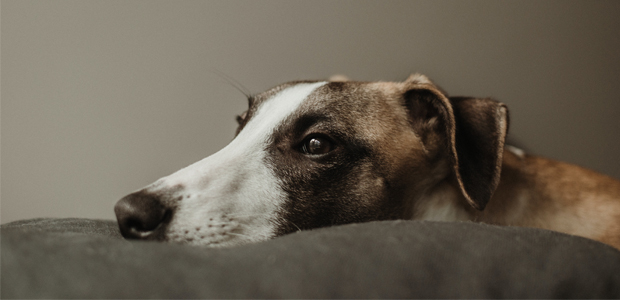Did you know that nearly 80% of pets suffer with anxiety in one way or another? You might think that pet anxiety is confined to just a few nights a year, when there are fireworks or thunderstorms, but pets can suffer with anxiety all year round.
Anxiety is the psychological, physiological and altered behavioural state of an animal anticipating either an actual or potential threat to their wellbeing or life.
March is pet anxiety month, so here we’ve provided a run-through on anxiety and what you can do to help your dog.
What causes anxiety in dogs?
Anxiety in dogs has several contributing factors, which include - breed type, genetics, personality type, lack of adequate socialisation/habituation, inappropriate experiences, concurrent diseases (e.g. cognitive dysfunction, pain) etc.
Signs of anxiety can be triggered in any of the following situations:
- Separation from humans or other dogs
- Noises – thunder, fireworks, alarms etc
- Unfamiliar dogs/people
- Traffic
- Car travel
- General husbandry – grooming, vet visits, nail clipping, putting lead on etc…
What are the signs of anxiety in dogs?
Dogs react to stressful situations in different ways, but some of the common signs of anxiety, include:
- Hypervigilance
- Withdrawal
- Trembling
- Lip licking
- Ears pinned back
- Excessive panting
- Yawning

Read More: Knowing your dog’s body language
Are some dog breeds prone to anxiety?
Although any dog can become anxious, there are certain dog breeds that may be more prone to developing anxious behaviour which can be related to what functions they were originally bred for. Examples include:
- Herding breeds - Border Collie, German Shepherd, Shetland Sheepdog
- Guarding/working breeds – Husky, Schnauzer, Tibetan Terrier
- Hunting breeds – Labrador, Cocker Spaniel, Vizsla
- Toy breeds (bred for companionship) – Chihuahua, Maltese, Bichon Frise
How to help dog anxiety
Training! From an early age, dogs need careful exposure to different environments and situations so they can build positive associations with them. This will mean they are less likely to become worried as adults.
Examples include being left alone, grooming, socialising with people and dogs, familiarizing them with different environments, introducing them to lots of new playthings (cardboard boxes, noisy kids toys, things that move etc.).
For those dogs already suffering from anxiety, seeking help from a qualified, positive reinforcement behaviourist is the best thing to do.